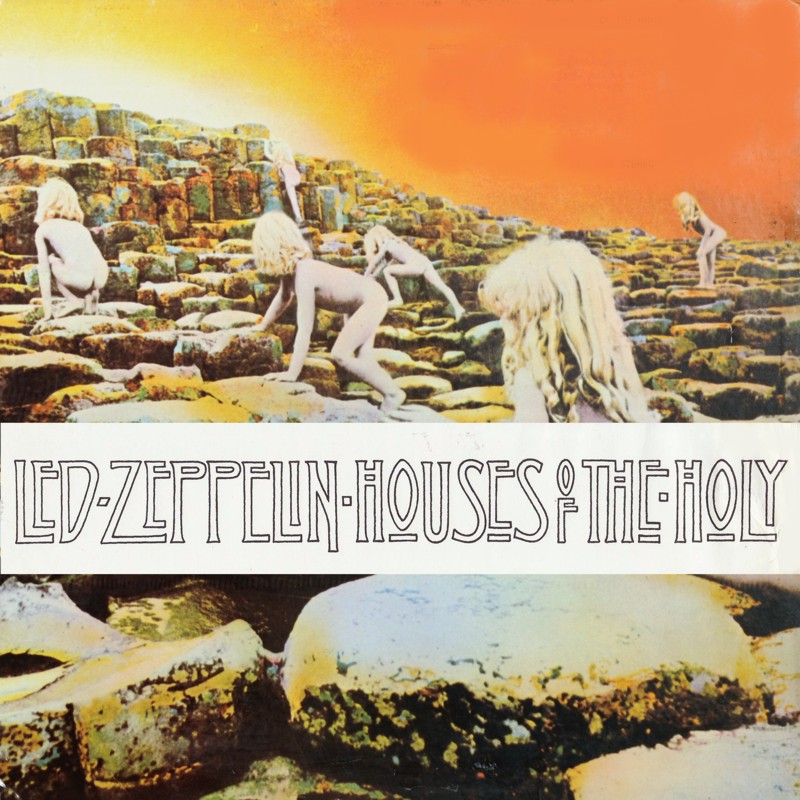On the release of Houses of the Holy in 1973, there simply wasn’t a bigger band on the planet than Led Zeppelin. Over their first four albums they had perfected blues rock, invented heavy metal, and then fused that folk influences, released a fourth album that was so anticipated that it required neither a title, nor the band’s name on the artwork to sell it. Having already eclipsed the solo careers of all four former members of The Beatles and Bob Dylan, Led Zeppelin were the new yardstick by which rock and roll success and excess was measured.
But having pretty much nailed down heavy rock, what new sonic territory was available to explore? Well what else was out there selling albums in eye watering numbers? 1973’s Houses of the Holy was the moment where Page, Plant, Jones and Bonham went all in at having a crack at this progressive rock thing, thereby neatly sidestepping the unenviable task of following up Led Zeppelin [IV] with something bigger and better, by just going ‘Hey, we can do this stuff too you know!’.
The tone of Houses of the Holy is quickly set with the opening pairing of “The Song Remains the Same”, “Rain Song”, and “Over the Hills and Far Away”, a trio of dramatic epics that confirmed that this album was the sound of Led Zeppelin showing that they could do extended song structures at least as well, if not better than, the likes of Yes or Emerson, Lake & Palmer. Of course, Zeppelin weren’t exactly strangers to the multi-part epic, as a little number called “Stairway to Heaven” had previously demonstrated. Houses of the Holy would prove to be chock full of them though, and was the album where the band took full advantage of John Paul Jones knowing his way around a keyboard and his talent for lush arrangements. Of course, this meant there was precious little room for a straight forward rocker in the mould of “Communication Breakdown”, “Whole Lotta Love”, or “Black Dog”, so there was no obvious single on the album outside of maybe “Dancing Days” or album closer “The Ocean”, but hey, Led Zeppelin didn’t release singles, so that just didn’t matter. Led Zeppelin were Led Zeppelin and could do what the hell they wanted when they wanted to do it. No album expected every twelve months for these guys!
Of course Houses of the Holy wasn’t just Led Zeppelin getting the prog out of their system, as “D’yer Mak’er” was a committed, if somewhat clumsy attempt at assimilating a reggae influence into their sound, and “The Crunge” was a slightly more successful stab at going all funky on us. You can hear Page and Jones getting into their grooves, but John Bonham’s skin pounding remains unmistakably heavy rock (though admittedly, his drumming on “D’yer M’aker” is one of the best things about that song), and Plant pleading for directions to the bridge is just forcing the point.
Houses of the Holy closes in a similar manner to the way it starts, with Zeppelin demonstrating they can do progressive rock with the best of them. “No Quarter” finds John Paul Jones making a bid for a place among the organ bothering greats of the decade, backed up by one of Page’s most iconic riffs, while “The Ocean” finds Led Zeppelin celebrating themselves and their fans with one of their best rock epics, another stand out riff, an outstanding closing 75 seconds (hell they even manage to crowbar some doo wop into it), and maybe, just maybe, one of the greatest hard rock singles never released. Oh, and Bonham’s elephantine drumming.
Houses of the Holy is the sound of Led Zeppelin demonstrating that they were much more than the sound and style that they themselves had established, by expanding their range and experimenting with other styles of music that were proving popular at the time. For a lesser act it might have proved a disaster, but for some, myself included, Houses of the Holy is one of Led Zeppelin’s most curiously under-appreciated albums, along with Led Zeppelin III, simply because it is one of the albums on which they sound the least like Led Zeppelin.
Houses of the Holy is an album with a tremendous amount of replay value, but it might not be the best place for the newcomer to Led Zeppelin to start. Instead it is an album that adds depth to their catalogue rather than an all out crowd pleaser. It is an album which is subtle, nuanced, and complex, which is a hell of a thing for Heavy Metal to achieve.














No Comment